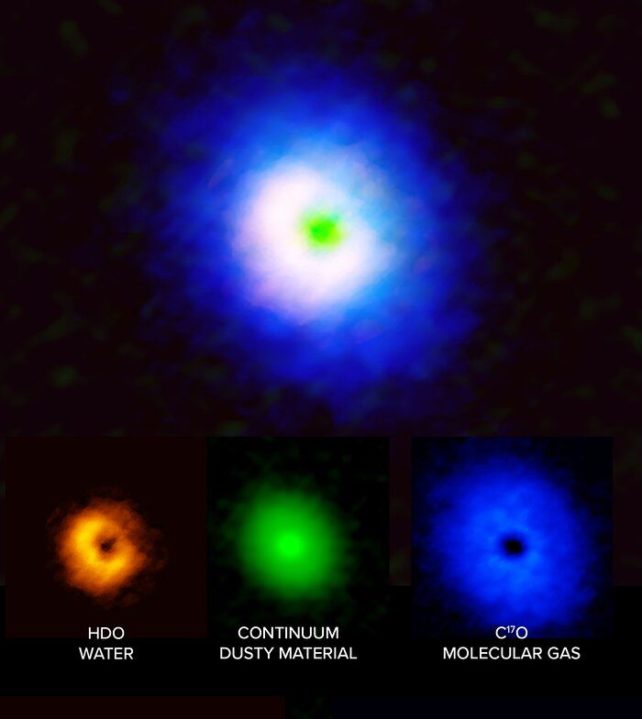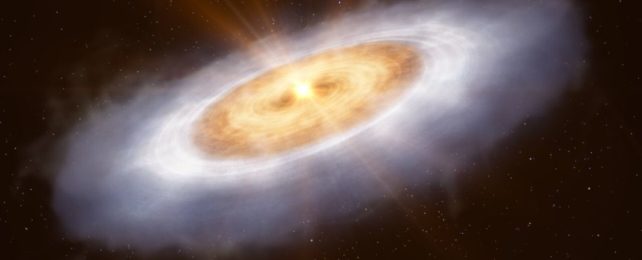A star 1,300 light-years from Earth might have just revealed one of the Solar System's best-kept secrets.
It's called V883 Orionis, a young star surrounded by a huge disk of material that will one day coalesce into orbiting planets. It's in that disk that scientists have made an unambiguous detection of water vapor, swirling around with all the other dust and gas destined to become part of an alien world.
This suggests that the Solar System's water – including that now on Earth – was present in the gaseous cradle from which the Sun was born; that it was here, not just before Earth, but before the Sun, and helped our planet grow.
"We can now trace the origins of water in our Solar System to before the formation of the Sun," says astronomer John Tobin of the US National Radio Astronomy Observatory.
Water is fairly common throughout the Universe, though Earth in particular wouldn't be the same "pale blue dot" without it. It curls around the planet's surface, permeates the atmosphere as vapor, falls down from the sky. It seems pretty mundane to us, but we wouldn't be able to live without it; almost all life's chemical processes require it.
It's also an important ingredient in planet formation. Stars are born from clouds of dust and gas in space; a dense clump collapses under gravity and, spinning, starts spooling in more material from the cloud around it that forms into a disk that feeds into the baby star.
Once the star is done growing, all the other features of the planetary system form from whatever remains of the disk. Dust grains stick together electrostatically, forming larger and larger clumps until the object is massive enough for gravity to take over.
Water is thought to play a significant role in this process; beyond the point at which water vapor freezes – called the snowline – it coats dust grains as ice, giving them an additional stickiness that helps particles cling together in the very first stages of planetary growth.

We can gauge where and how water forms based on isotopes of hydrogen. Normal hydrogen has no neutrons in its nucleus. Heavy hydrogen, also known as deuterium, has one neutron in its nucleus. Water molecules that include heavy hydrogen is known as heavy water, and it forms under conditions that differ from those that make normal water.
Here on Earth, we can trace some water to comets because the water-to-heavy water isotope ratios are similar. This suggests that water can be bound up in comets and asteroids and delivered to planetary bodies. But how the water got into the comets had not yet been completely accounted for. Now, by studying V883 Orionis, Tobin and his team have filled in that gap.
"We can think of the path of water through the Universe as a trail. We know what the endpoints look like, which are water on planets and in comets, but we wanted to trace that trail back to the origins of water," Tobin says.
"Before now, we could link the Earth to comets, and protostars to the interstellar medium, but we couldn't link protostars to comets. V883 Ori has changed that, and proven the water molecules in that system and in our Solar System have a similar ratio of deuterium and hydrogen."
The star is so young that it's still growing, surrounded by a huge disk. By studying the light given off by that disk, the researchers have been able to identify the spectral signature of water vapor; even better, they've identified the hydrogen isotope ratios.
"V883 Orionis is the missing link in this case," Tobin says.
"The composition of the water in the disk is very similar to that of comets in our own Solar System. This is confirmation of the idea that the water in planetary systems formed billions of years ago, before the Sun, in interstellar space, and has been inherited by both comets and Earth, relatively unchanged."
What makes V883 Orionis so special is that it's been undergoing a burst of accelerated growth, which means it's temporarily hotter than usual. Most water in the accretion disks around protostars is frozen, existing as vapor only close to the star, where it's hard to make out. V883 Orionis's activity burst, however, has pushed its snowline out to a point much farther from the star than usual; any water closer than that snowline is vapor.
Vapor is a lot easier to detect and analyze than ice, so the researchers were able to make a confident measurement of the isotopic composition of the water in V883 Orionis's disk, as well as quantify it. There's over 1,200 times the volume of Earth's oceans, drifting as vapor around V883 Orionis.
The findings suggest that all the water in a planetary system comes almost directly from the clouds from which its star is born.
"We conclude that disks directly inherit water from the star-forming cloud and this water becomes incorporated into large icy bodies, such as comets, without substantial chemical alteration," the researchers write in their paper.
"Although the specific delivery mechanism of water on Earth remains debated (comets and/or asteroids), the [hydrogen isotope ratio] found in V883 Ori is evidence that the water molecules in our Solar System originated in the cold interstellar medium before the formation of the Sun. Therefore, spatially resolved water observations towards young planet-forming disks are crucial in linking the water reservoir and the formation of terrestrial planets."
The research has been published in Nature.
